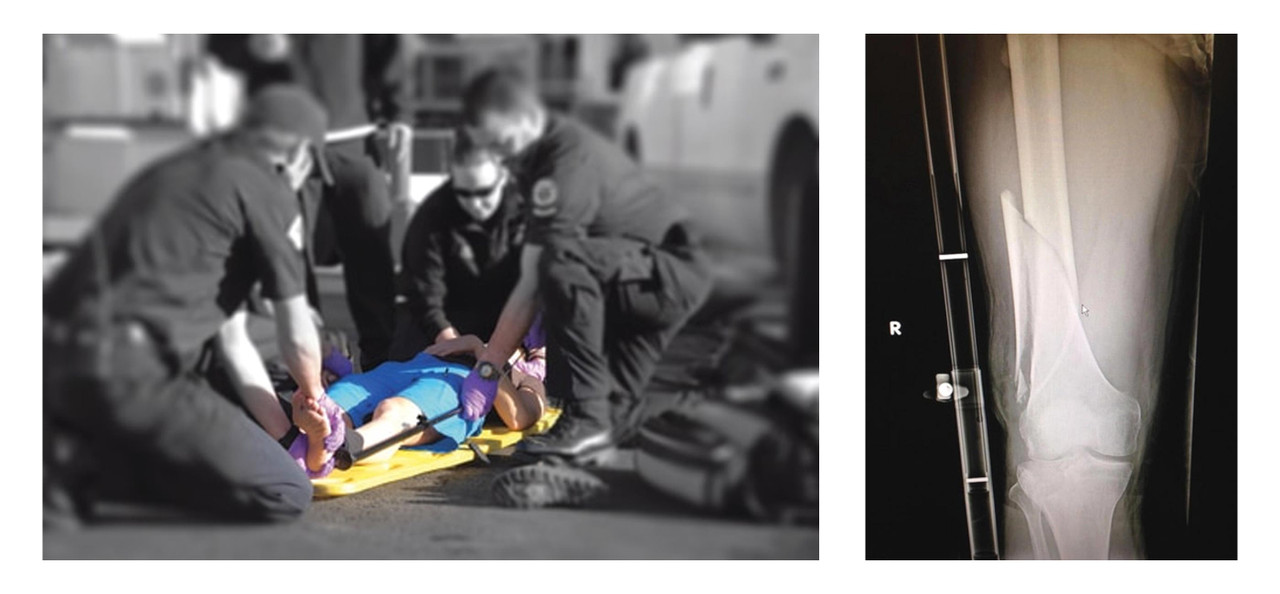Traction Splints: Everything You Need to Know
When it comes to orthopedic emergencies, few injuries demand faster attention than femur fractures. Conscious patients with fractured femurs automatically grab their thighs in an effort to splint and “auto-traction” their own legs to combat the spasm/pain cycle. Traction splints provide external scaffolding to take over the job that the femur is built to perform inside. By stabilizing and applying traction to femur fractures, there is also less risk of bleeding into the thigh. Whether stabilizing clots or traction is more important is hard to be certain. But without a doubt, liters of blood can balloon a thigh surrounding a fractured femur. As such, a fractured femur can cause life-threatening complications if not managed properly. Therefore, one of the most critical tools to care for this injury is the traction splint.
What is a Traction Splint?
A traction splint is a medical device designed to stabilize a fractured femur, while also stretching the surrounding musculature. When muscles contract surrounding a femur fracture a cycle of pain and spasm develops. Traction splints disrupt this vicious cycle which results in diminished pain. Splints, in general, facilitate clot formation as well. It is hypothesized that traction can also reduce blood loss into a thigh. But this is difficult to prove or disprove because splinting itself is a confounder.
- Primary use: Femur fractures
- Goal: Reduce muscle spasm, minimize pain, and decrease hemorrhage
- Environment: Commonly used in prehospital emergency medicine (EMS, military, rescue operations), as well as trauma centers
When is a Traction Splint Used?
Key benefits of traction splinting include:
- Pain relief
- Reduced muscle spasm
- Decreased hemorrhage
- Easier patient transport and handling
Traction Splint Quick Quiz
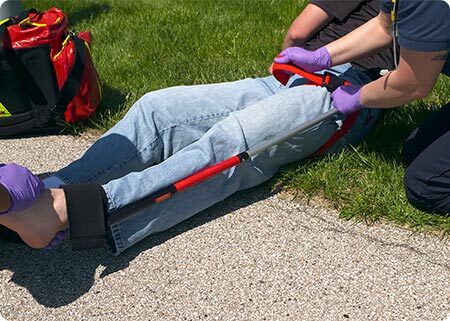
Multiple Choice: When is a traction splint contraindicated (when NOT to use a traction splint)?
A) Suspected proximal femur fracture
B) Suspected knee fracture
C) Concurrent foot amputation
D) Concurrent pelvic fracture
E) All of the above unless you are using a Slishman Traction Splint
ANSWER: E
Previous iterations of traction splints have limitations on when a splint can be used, however the Slishman Traction Splint was designed to overcome the above common contraindications.
True or False?
Question: A traction splint should not be used for open fractures?
Answer: Partially true and false. A Slishman Traction Splint can be used, but try to avoid pulling organic matter on exposed boney fragments back into an open wound.
Traction Splint for Hip Fracture: Is It Appropriate?
Legacy traction splints are not generally indicated for hip fractures. These devices are specifically designed for femoral shaft fractures. However, Slishman Traction Splints are splints first that just happen to offer traction. If you are unsure of the location of the fracture, it is ok to splint. Some patients with fractured hips feel pain relief from traction as well.
Comparison of Common Traction Splints
Traction splints have evolved since the 1800’s, starting with the Thomas splint. The following helps to understand the stages of development, and the differences between splints commonly used in present day operations.
Thomas Traction Splint - Whole-ring and half-ring traction splints
In the 1800s these were invented, but they gained popularity during World War I. Made of steel, these traction splints featured continuous rods extending alongside injured legs and beyond the patient’s feet. With numerous mid leg straps, they create a cradle. An ankle hitch attached to rope, cord or webbing enables the traction.
The following is an excellent demonstration:
Key Features: Steel frame, extends beyond leg
Advantages: Strong, cradles leg, customize to fit patient
Limitations: Large frame, long application time
Best Use Cases: In-hospital or long-term traction
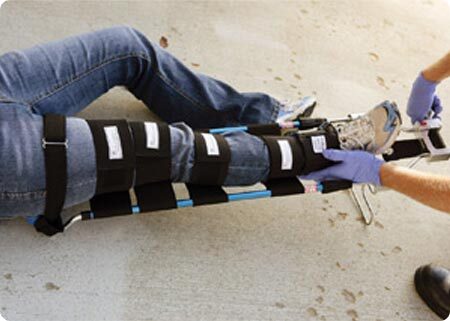
Hare Traction Splint
The Hare Traction Splint offers a more padded proximal crossbar as well as some degree of length adjustment compared with the Thomas traction splint. Traction comes from a ratchet mechanism distal to the foot, which pulls webbing that is attached to an ankle hitch. Multiple midleg straps are included to cradle and lift up the injured leg. An adjustable end stand props up the leg which limits pressure on the proximal crossbar.
Pediatric versions of the Hare Traction Splint exist as well.
Because of the proximal crossbar, traction splints are contraindicated for proximal femur fractures.
Key Features: Extends beyond leg, traction from the foot
Advantages: Smaller than Thomas, cradles leg
Limitations: Large frame, long application time, requires carrying peds and adult sizes. Contraindicated for proximal femur fractures.
Best Use Cases: Common legacy splint for some EMS agencies
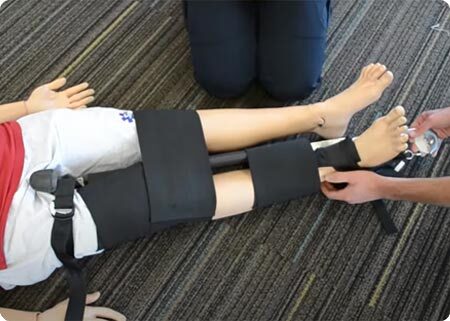
Sager Traction Splint
The Sager was invented in reaction to the Thomas and the Hare type traction splints in an effort to offer more comfort and to remove the proximal crossbar, which can cause pain and can exacerbate proximal femur fractures. The Sager is the first traction splint to offer quantifiable dynamic traction as well. This feature helped to teach the world that not much traction is required for patients with broken femurs to feel better. More than 15 pounds is typically excessive and often people feel better with less. The Sager offers bilateral traction as well.
You will find two general variants of the Sager; one with a tension dial which extends further beyond the foot and another with a grip handle, which can be found medial to the ankle which can be pulled to deliver traction.
A pediatric version is available as well.
Because the Sager applies focal pressure to the ischium, it is contraindicated when pelvis fracture is suspected. It also cannot be used if a patient has concurrent lower extremity trauma.
Key Features: No proximal crossbar. Offers bi-latteral traction.
Advantages: Improved comfort vs. Thomas and Hare
Limitations: Long application time, loose parts, requires carrying peds and adult sizes. Contraindicated when pelvis fracture is suspected and for lower extremity trauma.
Best Use Cases: Common legacy splint for some EMS agencies
Donway Traction Splint
The Donway shares features of the Hare and the Sager. It never became available in the US, but found greater acceptance in countries such as the UK, Australia and New Zealand.
Like the Hare, it cradles and injured limb between two poles connected by a padded crossbar. A pneumatic pump is used to deliver Traction is delivered from the foot using a pneumatic pump, and the pressure gauge can be used to infer traction.
A pediatric version is available as well.
Key Features: Traction is applied pneumatically. Built-in gauge shows force applied.
Advantages: Sturdy, provides traction force details.
Limitations: Large system, longer application time, loose parts, requires carrying peds and adult sizes. Contraindicated with lower limb injuries.
Best Use Cases: Common for some EMS agencies in UK, Australia and New Zealand.
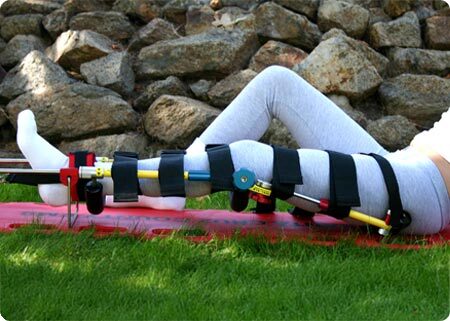
REEL Splint
There was a phase of medicine when splinting in the position of injury was considered more appropriate. This is part of what led to the REEL Splint. No other traction splint involves more engineering, and no other traction splint offers more articulation and general adjustability. However, over time it has become clear that position of injury splinting does patients no favors. Paramedics, fire fighters and combat medics are more empowered now to attempt to realign injuries to achieve better perfusion and to enable transport.
REEL Splints are also quite bulky and require more practice and time for application.
These splints (NSN 6515-01-250-8936) are no longer in production.
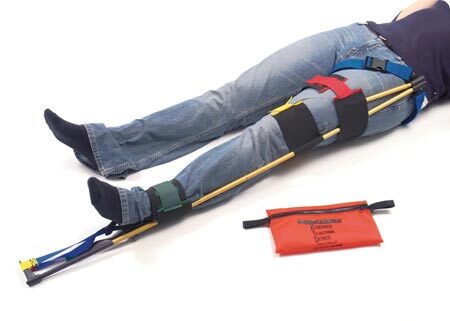
Kendrick Traction Splint
The “KTD” represents a design leap because it demonstrated that femoral traction could be delivered from a much more compact package. Using a design you might find to assemble a camping tent, the chosen length is defined by placement of the groin strap. Like all other traction splints of the 19th and 20th century, the KTD offers a distal point of traction; meaning the caregiver must be positioned at the foot to deliver traction. In the case of the KTD, the lateral monopole extends some distance past the foot to enable traction using a webbing-based cinch.
The KTD is the first traction splint that could claim “one size fits all”, meaning that a pediatric version was not needed.
KTD’s utilize three midleg straps as well, which help to keep the aluminum pole from bowing outward when traction is applied. They also help to stabilize the injured limb.
KTD’s became very popular with skiers, search and rescue teams, and anyone with space constraints, such as flight medics. In some settings they were treated as single use, disposable as well.
Key Features: Lighter and more compact package than earlier traction splint iterations.
Advantages: Lighter, one-size-fits-all
Limitations: Extends beyond foot, traction is applied from the foot.
Best Use Cases: Became popular for responders with space contraints
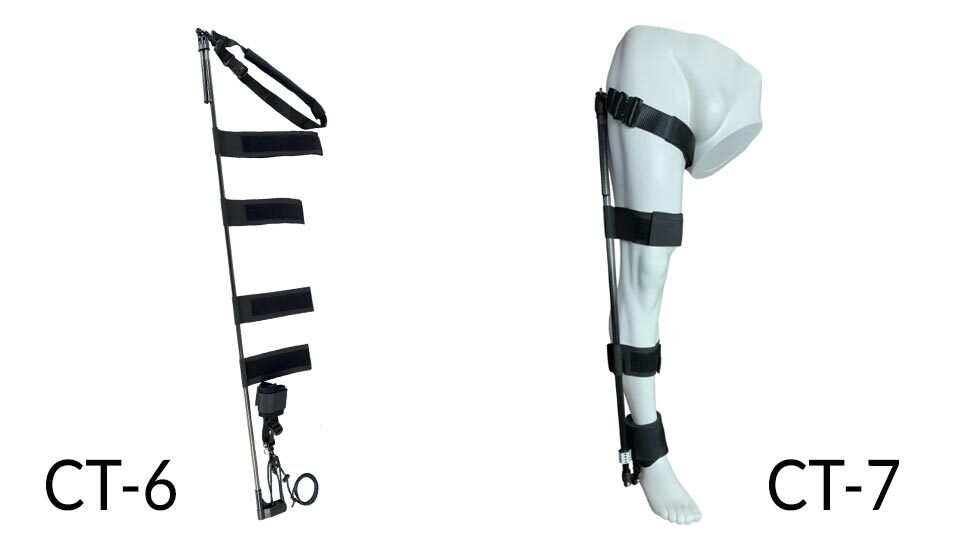
CT Traction Splints
Key Features: Compact, all peices are attached to the unit.
Advantages: More compact than previous designs.
Limitations: Achieving desired traction is slow, patient cannot adjust as needed.
Best Use Cases: EMS and tactical environments.
CT-6
Invented and brought to market by Faretec, the CT-6 shares many of the same features as the KTD. There are three main differences:
- The midleg straps are attached to the lateral monopole, reducing confusion and making them less likely to be lost.
- Manufactured with carbon fiber instead of aluminum.
- Distal traction is delivered using a pulley system, offering more mechanical advantage.
CT-7
To limit extension beyond the foot, the CT-7 utilizes an ACME screw rather than a pulley mechanism to deliver traction. The distal ankle strap is neoprene and can detach from the carbon fiber pole.

Slishman Traction Splint (STS)
There are three Slishman Traction Splints on the market, the STS Original, the STS-C and the STS-Gen2. Like the KTD, CT6 and CT7, they are all lateral monopole splints. The most notable differences are:
The original STS uses thumb screws to lock the poles in place whereas the outer tubes of the STS-C and STS-Gen2 lock in place with spring buttons. Also, the traction cord itself locks into the V-cleat the STS-C and STS-Gen2.
Slishman Traction Splints have no absolute contraindications either because they are splints first that just happen to offer traction.
Because the Sager applies focal pressure to the ischium, it is contraindicated when pelvis fracture is suspected. It also cannot be used if a patient has concurrent lower extremity trauma.
Key Features: Single-piece lateral telescoping monopole for fast and easy application. Aluminum outer and middle tubes, with plastic inner tube. The only traction splint offering traction from the hip using a pull cord lock/V-cleat lock mechanism.
Advantages: Easy to apply in less than one minute. Lightweight and compact No extension beyond the foot eliminates inadvertent “door strikes”. Proximal point of traction gives patient autonomy in adjusting traction. One-size fits all. Relatively radiolucent. Rigidity makes midleg straps unnecessary. No absolute contraindications. Well-padded pressure points. “A splint first that just happens to offer traction.”
Best Use Cases: Any patient who says “I think I broke my leg” is a candidate. Apply in the field. Leave on through the ER, through radiology and all the way to the floor bed or the OR. Popular among flight medics, firefighters, paramedics, and ski patollers.
Traction Splint Case Studies
Scenario: Combat medics evaluated multiple splints during training exercises.
Outcome: The STS was applied significantly faster than other models like the CT-6 and REEL Splint. Users also reported the highest confidence in their ability to treat femoral fractures effectively with the Slishman Traction Splint.
Evidence: A comparative study showed STS had faster application times (p < .0028 vs CT-6; p < .0001 vs RS) and highest user-confidence scores (p < .00229).
Scenario: EMS personnel recount using STS on-field during femur fractures encountered in mountain rescue and trauma calls.
Outcome: Patients reported almost immediate pain reduction (from 10/10 to about 3/10), and responders emphasized how lightweight, portable, and fast to apply the STS is—even noting that a single person could apply it on themselves in roughly two minutes
Source: Reddit Thred: Traction Splinting — What does your agency do?

About the inventor of the Slishman Traction Splint
Dr. Sam Slishman, an emergency medicine doctor, saw the obvious need for a revolution in traction splint design. At the time (and some that are still used today), pre-hospital traction splints were cumbersome, heavy, and contained many parts and pieces, and required carrying multiple sizes (adult, pediatric) – these factors made it difficult and time consuming to apply in the field, which resulted in many instances where responders just didn’t apply a splint at all, with the mindset that rushing to the ER would be in the patient’s best interest.
If the splint did actually make it on the patient (and was applied properly), additional challenges were presented. Legacy traction splints would stick out past the foot, making it difficult to manage the patient in a tight space (think back of an ambulance or on a helicopter); traction had to be adjusted from the foot, not from a position where you would be monitoring the patient’s other injuries or vitals.
Typical contraindications such as lower leg injuries or amputations did not allow femoral traction devices to be applied either.
With these limitations and hurdles in mind, Dr. Slishman was inspired by a telescoping ski pole – a simple concept to achieve linear traction. This led to the design and development of the revolutionary traction splint known as the Slishman Traction Splint, or STS. The compact, lightweight design is practical for a wide variety of use cases, including military, wilderness rescue, and EMS, and has quickly become the go-to splint for large agencies around the world, including FDNY, Boston EMS, Dallas Fire-Rescue, National Ski Patrol, medical teams in Australia and Europe, and many more.
Years ago, improvements were made to the internal workings and external components to advance the splint even further, and to create a compact version (the STS-C) intended for military and backcountry use where space and weight are essential factors. The same improvements were incorporated into the full-length splint (STS Gen 2).
Are you interested in learning more about the Slishman Traction Splint? Contact us to speak with our experts, get more information, sign up for a demonstration, or get a sample splint. [link to Microsoft form for STS info]
